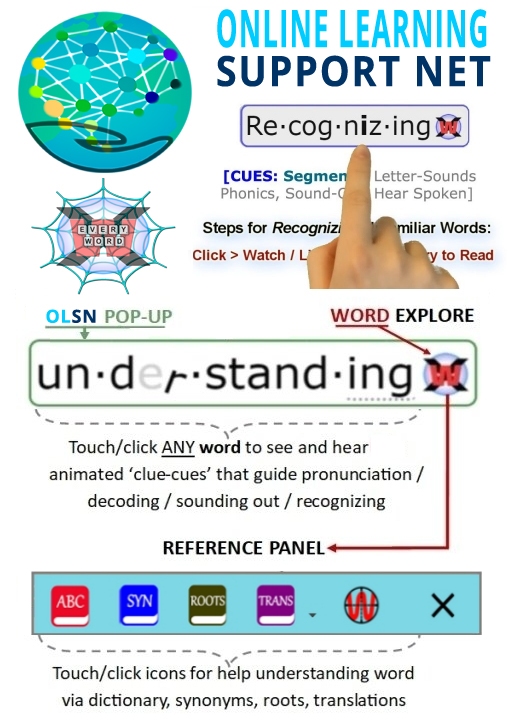The Compass of Shame
Note: Remember to click on any word on this page to experience the next evolutionary step in technology supported reading.
The Compass of Shame
Dr. Donald Nathanson: You see, if shame is a spotlight just like all the other affects, if shame is a spotlight that pulls the neocortical cognitive apparatus to focus our attention in a shame based manner, then every shame experience focuses us on incapacity, deficit, failure; all kinds of things about our worst possible self. The spotlight does that. It’s not a spotlight anybody particularly likes. So what we do from earliest childhood is we find a number of ways to get away from what the spotlight has evolved to show us.
Rather than maintain our attention on what feels awful about us, on our worst possible self, we learn from earliest childhood a pattern of four styles of behavior, each of which reduces the likelihood that we’re going to focus on what’s wrong with us. I call this pattern of responses the Compass of Shame. We go into the Compass when we don’t look at what the spotlight is showing us.
David Boulton: Would you say that you could also describe the compass as an escape from the feeling?
Dr. Donald Nathanson: Yes.
David Boulton: Okay. I think that’s short and powerful. I don’t want to feel that feeling, I want to escape from that feeling and we have four different escape routes.
Dr. Donald Nathanson: As I’ve been saying, shame is one of the spotlights that makes us feel terribly uncomfortable. It’s not the worst, it’s not the only one, but it does make us terribly uncomfortable and it makes us focus on things we really would rather not know about ourselves. There is an escape route. It’s not a great route, but everybody uses it.
When we don’t want to focus, when we want to get away from what the spotlight of shame is trying to show us, we move over to what I call the Compass of Shame. It’s an escape route, it’s a safety route. It’s a place where we can feel better than we’re going to feel if we look at what shame has evolved to show us. For the moment, working, living in the Compass of Shame feels better. It’s not terribly good for our future and it’s not terribly good for the development of an authentic sense of self, but it sure feels better.
What are these four poles of the Compass? The first we call Withdrawal, and in that mode we withdraw from the eyes before which we’ve been shamed.You see it a little bit in the physiology of shame because we slump like so. Well, at the Withdrawal pole we slump and move away from the eyes of others even more. If shame affect, if the physiology of shame, decreases or cuts our connection with others, the Withdrawal pole…
David Boulton: The withdrawal, in a way, is this shrinking back within, a contraction away from the feeling.
Dr. Donald Nathanson: Yes, it’s a withdrawal into the self. It’s a complete loss of connection. Let me go over that. Let’s look for a moment as we shift from whatever the spotlight of shame was trying to show us to the Compass of Shame at the withdrawal pole. If the physiology of shame is that we turn away like this, the most natural first defense against shame is to pull away even more. We can pull into the self so we appear completely unconnected with anybody. We can really withdraw as the little kid does behind the hidden face or behind mommy’s leg or by running into another room, or an adolescent goes into her room so as not talk to anybody. That’s all the Withdrawal pole of the Compass of Shame.
The good part about withdrawal is that it does decrease the amount of shame we are feeling in that moment. The bad part is we’ve lost connection with others, and that’s pretty serious. It seems like it’s a win and it is a win for that particular moment of shame. But unless we learn what to do with shame and learn not to simply use withdrawal, we haven’t profited at all from what the spotlight has evolved to show us.
One of the problems with the Withdrawal pole of the Compass of Shame is that as we move toward withdrawal and away from others, losing connection with them so we’re not seen by them in our moment of shame. Many people have real problems with what we call abandonment, isolation, being shorn from the herd. One of the things that shame does is to shear us away from others.
Well, some people just don’t want to have that feeling of abandonment, all of us sometimes and some people a lot of the time. So they reduce themselves so that another powerful person will take pity on them and make them feel less alone. They maintain themselves as a lesser being and they get the power of another person and we call that the Attack Self (diminish self) pole of the Compass.
The healthiest expression of this is when we might say yes officer, five miles over the speed limit, thank you very much sir. That’s healthy deference. What’s that line, where does an elephant sit? Anywhere it wants. That’s healthy, reasonable deference to power, but at the pathological end when we say to someone beat me, kick me, spit on me, treat me with contempt, just don’t leave me alone, that use of the Attack Self pole of the Compass of Shame is what we call masochism. It’s a terrible place to be in its most exaggerated form. In a classroom situation we’re supposed to say yes teacher, thank you very much. We defer to the teacher’s authority even though we’re feeling shame.
Well, there are a lot of people who don’t like withdrawing and they sure don’t like being falsely deferential and they don’t know any way to make the feeling of shame go away, so what they concentrate on is some piece of behavior or acquisition of a skill that makes them feel good about themselves. We can learn some sport and we can make our prowess at that sport the center of our identity for others so that even if I’m not very good at reading, I can be great at volleyball or basketball or something else. I don’t need to read while I’m on the basketball court, but I can feel really good if I can sink that ball. I can box, I can learn martial arts. There are a lot of things I can do, not just for their own pleasure, but because they give me a place of safety away from what the spotlight of shame was going to show me.
It’s great to look beautiful. It’s great to enjoy sexuality. It’s great to do a lot of things that feel good. But when you use them to shift attention away from what might bring you shame toward a competent, glorious self, that’s what we call the Avoidance pole of the Compass of Shame. Most behavior at the Avoidance pole is relatively normal. We all like to look our best, we buy neat clothes, we might buy a great car, we like jewelry; there’s lots of stuff our culture trains us to do, buy, and act at the Avoidance pole. But the important thing is that to the extent we do this in order to avoid shame we’re not learning what shame wants to show us.
There are other things we can do at the Avoidance pole. It just so happens that alcohol makes the feeling of shame go away. In fact I’ve said often that shame is soluble in alcohol and boiled away by cocaine and the amphetamines. These drugs, which we sometimes call courage in a bottle, prevent the feeling of shame from taking hold. A good stiff drink will ward off the horrible feeling of shame. So this Avoidance pole is a pretty big part of our culture.
Now, there are times for all of us and a lifestyle for many of us when there’s nothing we can do that makes us feel good about making shame go away. So what we learn to do is to diminish somebody else by the put down. Diminishing somebody else, putting someone else down is what we call that the Attack Other pole of the Compass, and that’s what abuse is, laughing at someone, derision. All these ways that we can reduce somebody else when we feel diminished by what the shame spotlight is showing us, all of that is what we call the Attack Other pole of the Compass of Shame.
The four poles of the Compass of Shame: Withdrawal (hiding), Attack Self (deference), Avoidance (look where I want you to look) and Attack Other (put down). Pretty soon the child learns at every age all four poles. The role of reading in this is pretty important. Because if this is the major experience children are having as they enter the education process and they can’t read because there’s something wrong with the code itself, then we’re exposing children to an unnecessary amount of shame experience that they must defend against when they are least skilled at handling shame. And if we can do anything to reduce the humiliation kids feel in school, we’re going to have a generation of kids who can learn far better than they ever have.
Donald L. Nathanson. M.D., Clinical Professor of Psychiatry and Human Behavior at Jefferson Medical College, and founding Executive Director of the Silvan S. Tomkins Institute. Source: COTC Interview – http://www.childrenofthecode.org/interviews/nathanson.htm#CompassofShame
The Four Poles of the Compass of Shame
Dr. Donald Nathanson: So uncomfortable is the feeling of shame when that affect spotlight hits us that we learn very quickly ways of disavowing, getting away from the bad feeling. We call the way that is done the Compass of Shame. We can withdraw so that we’re not seen by the eyes of others. We can withdraw so that whatever has been revealed about us will no longer be seen by others. We can curry favor with others so that we don’t feel alone even though we feel defective. We can do something to turn off the feeling of shame by using drugs or calling attention to what we’re good at. Or we can diminish the self esteem of others and feel better than we did before shame hit. Those four forms of behavior: Withdrawal, Attack Self, Avoidance and Attack Other, that’s the Compass of Shame and that’s what we do to get away from the bad feeling of physiological shame.
You know, when people say I’m having a bad hair day that’s just a shame thing. Nothing I do makes me feel good about myself.
David Boulton: I’m having a bad hair day is on the spectrum with I’m not that smart, I’m not a good reader, reading is not that important. These are various ways of creating some kind of a definition that takes me out of the experience of the shame, some model that keeps me away from that feeling.
Dr. Donald Nathanson: Remember how popular Jimmy Stewart was when we were kids? He represented forthright definite statements of what he could do and no exaggerations about any aspect of his personality. He did that in every character that he played. Today a hero, a movie star, is one who calls attention to his attributes, who brags, who shows off something about him self, not someone who’s low key, comfortable with himself and able to take anything that happens. The hero today in the American movie, he or she is someone who takes a possible insult or assault and fights back. That’s the key to the personality of today: avoiding shame and attacking others.
Let’s look at the way people manage shame in our culture. The first thing we can do, of course, is look where the spotlight of shame might point us; to evaluate, see what’s wrong with us and make changes. We don’t do that very often because it hurts. So what do we do? We’ve got this Compass of Shame. At the top there’s the Withdrawal pole of the compass. That’s everything we do to keep away from the eyes that have seen what’s wrong with us. That’s why we say in shame we are shorn from the herd. We lose our connection to others, we pull away from everybody so that nobody really focuses or maintains attention on what we are afraid they’ll see.
The Attack Self pole is simple. When we pull away from the herd of course we’re alone. Well, we vary, you, I and everybody in how comfortable we are being entirely alone. Some people who are very much afraid of abandonment can’t stand the idea of being entirely alone so they’ll curry favor with someone powerful and they’ll diminish themselves and say I’m not worthy and you’re so wonderful in hope that someone will fold them in and take care of them even though they’ll be degraded to an even lesser standing. We call that the Attack Self posture.
There are other people who don’t like any aspect of the feeling of shame and what they do is they want to make the feeling itself go away. They’ll focus your attention on some aspect of themselves that’s wonderful like how they climb the tennis ladder in a club, golf, baseball, football; becoming really great at something not for the sake of really enjoying your own skills, but for making sure other people notice who you are, notice your competence, your beauty, your sexiness.
Another way we can avoid the feeling of shame is simple. We can drink. Alcohol wipes away the feeling of shame better than any drug that’s ever been found. Cocaine and amphetamines raise the level of excitement so you don’t even notice what might have caused shame before. That’s the Avoidance pole of the compass.
The last pole involves a library full of ways we behave when we don’t know anything we can do that can make the feeling of shame decrease so we diminish somebody else. At least we’re going to feel better than somebody else for a while. That means hitting them, putting them down, mocking, doing things that are going to make another person feel awful. Bullying is nothing more than the Attack Other pole of the Compass of Shame. Just like abusive children, spouse, inferiors, underlings, that’s all the Attack Other pole of the Compass. Wouldn’t need to do that, you know, if you focused on yourself and just maximized your own abilities.
David Boulton: I always think of this last point like people are pushing down on other people to push themselves up. There’s this movement to push down on others which propels yourself up in relation as an avoidance. All of these Compass points share in common that they’re all an escape.
Dr. Donald Nathanson: Yes.
Donald L. Nathanson. M.D., Clinical Professor of Psychiatry and Human Behavior at Jefferson Medical College, and founding Executive Director of the Silvan S. Tomkins Institute. Source: COTC Interview – http://www.childrenofthecode.org/interviews/nathanson.htm#FourPolesCompass













